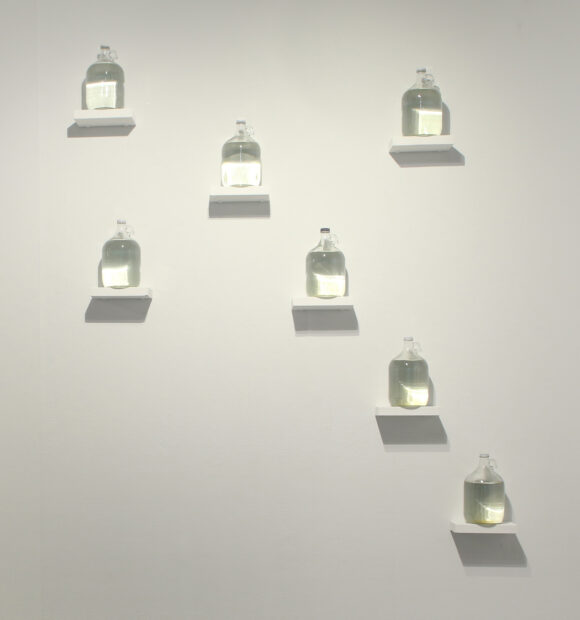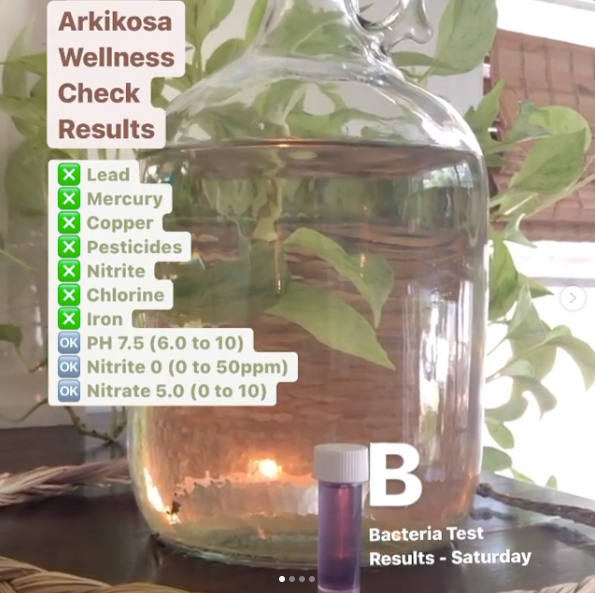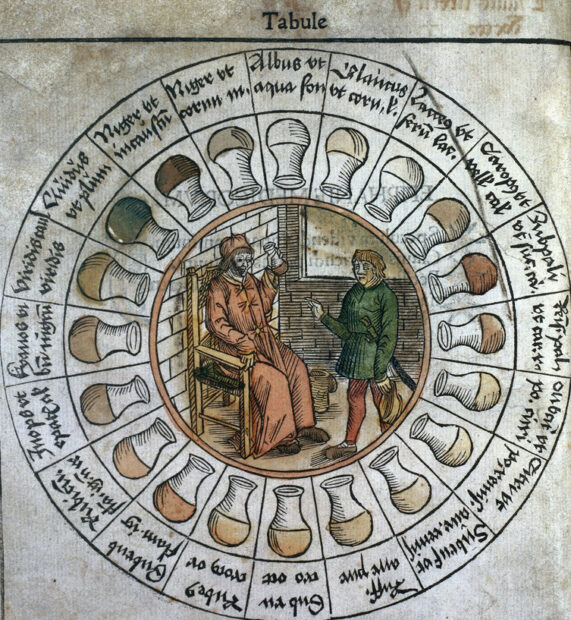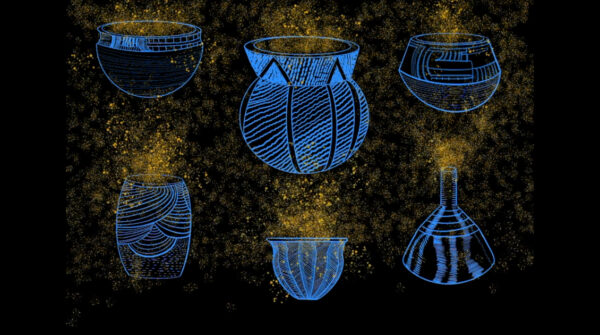
Installation view of Angela Faz’s show The Grammar of Animacy at the Fort Worth Community Arts Center. Image via the artist
As I wandered through the Fort Worth Community Arts Center, seven hefty glass jugs of transparent fluid — staggered on high, short shelves against a large, well-lit white wall — caught my attention. My eye immediately saw the water’s subtle, variable color tones.
This encounter was a part of Angela Faz’s multimedia exhibition The Grammar of Animacy, which focuses on the personification of the Arkikosa, (also known as the Trinity River), and its buddies, (the river’s West Fork, Clear Fork and Elm Fork), which together wind through Fort Worth, Arlington, Grand Prairie, Irving, and Dallas. The river’s story proves to be a potent and fertile subject that Faz wishes to “activate” in a variety of physical artworks, performances, tangible facts, and objects.
The glass jugs that initially caught my eye are filled with samples from various water location collection spots; the artist documents their nature hikes using samples taken at the water’s edge in specific locations.

A result of one of the Arkikosa’s “wellness checks.” Image via the artist’s Instagram, @thefaztastic
Faz’s process of officially testing their samples, (and the Arkikosa’s surprisingly “clear” bill of health), alludes to the artist’s environmental concerns and to their tendency of personifying the river.
“What kind of personality do they have?” I question about the Arkikosa, in a non-gendered approach (which is important to the artist). Faz includes in the exhibition a Decree for Land Autonomy and Stewardship, where the Plaintiff, the Arkikosa, asks “Who owns me?”
Arkikosa, petitioning for autonomy, liberation and legal personhood, is up against the City of Dallas. The Decree outlines Arkikosa’s bid to flourish, to naturally evolve, and, if properly cared for, to “provide the City of Dallas with a clean and healthy environment.”
The gold standard is also important to Faz’s work, particularly in relation to our changing and often fraught relationship with natural resources, including the relationship between gold and water.
Considering the personified Arkikosa’s health, based on the color of its water, is an approach that goes back centuries. Medieval alchemists organized the water of the human body into a wide diagnostic color spectrum. One chart from the period, for example, states:
“If White in color … Thin urine, white in color, is a sign of spleen, dropsy, intoxication, nephritis, delirium, diabetes, rheumatism, black bile, epilepsy, dizziness, chill of liver, or (with a bilious fever) death.”
Another chart cites 20 colors to measure water in the body, ranging from “white as wellwater” to “ruddy as pure intense gold.”
The alchemist’s color recognition included the Hippocratic humors of the human condition: melancholic, sanguine/optimistic, choleric/difficult and phlegmatic/calm. Even Goethe and Schiller’s 1798 Rose of Temperaments diagram stirs up the morality of color, along with color mixing theory. Therefore, is Arkikosa choleric, (tinged red/orange/yellow) for tyrants, heroes and adventurers? Sanguine (yellow/green/cyan), signaling hedonist, lover or poet? Phlegmatic (cyan/blue/violet), fostering an orator, historian or teacher? Or, melancholic (violet, magenta, red), for philosophers, pendants and rulers?
And, what, even, is the color of water? Ludwig Wittgenstein’s 1950 Remarks on Colour carefully documents the writer’s “atomic thoughts” about a variety of semiotic topics. Relevant here is his pondering of transparency, translucency, luminosity and opacity; his referencing of ghosts, milk, gas flames, and gold; and his notes on black water, blue water and white water.
I first encountered Faz’s work at the Dallas Public Library in 2019, when Faz, as founder of Radical Love Art Collective, curated Hecho a Mano. The group show, described on their website as “a journey about colonization where artists unpack their identities,” included pieces from their own Our Home series. These layered works feature prints of a Native American teepee/reed structure that overlaps images of a homesteader’s cabin (with satellite dish). Are the two shelters competing camps? In one piece, a faint, second teepee stains or crowds the only rectangular home. The teepee/reed structure also makes a reappearance along the flooding and receding river in The Grammar of Animacy’s video work, I am the Arkikosa.
Faz’s exhibitions since Hecho a Mano (at Women and Their Work and The Congressional Hispanic Caucus Institute), combined with the fact that they are also a successful designer (for Teatro Dallas), as well as a community activist, means that they are a strong presence in Texas’ art scene. And they’re no stranger to wrestling various multifaceted elements into a successful working model.
The Grammar of Animacy uses a spare palette of black, white, and saturated color. It includes various relief prints, wall text, a table setting, the jugs of river water, and the video piece mentioned above. As Faz investigates their river muse, we are invited to flow along the gallery path reading, looking, and listening.
The show’s video is exceptionally hypnotic. In a dark black field, we see the video come to life through Faz’s hand; imagery ebbs and flows, and entire environments are created alongside a natural soundtrack. It’s as if water mosquitos are playing rhythmic ripples on a slow-moving stream, and dots and dashes are opening a magical window into the river’s landscape and story.
Faz isn’t alone in their artistic fascination with rivers — San Antonio artist Liz Ward created, over a number of years, her Ghosts of the Old Mississippi series. And sculptor Roni Horn seems to have an obsession with the Thames: Another Water and Saying Water are among her many works. Ward and Horn, like Faz, reference the history and culture of their river’s world.
As a Dallas resident fascinated with New Mexico and Texas history, I’m aware of the area’s complex and often troubled history involving Native American tribes, Mexican citizens, Spanish Conquistadors, French trappers, and U.S. soldiers and homesteaders.
For Faz, these untold histories an ongoing topic. Their website catalogs a 2017 collaboration with DeColonize Dallas:
“Dallas is not Dallas, it is occupied former Mexico. Mexico is not Mexico, it is occupied former Wichita land. Uptown is not Uptown, it is occupied former Freedman’s Town. And the hundreds of thousands of forced migrants in Dallas, whether it be through the Transatlantic slave trade, Trail of Tears, Hurricane Katrina, or refugee resettlement system, are questioning what it means to be landless. Dallas is built upon a history of colonialism and violence obscured by respectability politics and a history of Accommodation.”
While in her river works Ward focuses more on elaborate, layered map-like watercolor paintings, and Horn sprinkles culture and Wittgenstein-like musings in the footnotes of her photography, Faz is vying to create a more immersive social narrative utilizing timelines, lab testing, and social media documentation. To this extent, The Grammar of Animacy also includes evolving, related video happenings, such as a fake restaurant, The Old Gold Standard, serving up humorous and biting video works, like Gold dust Cheetos +$1,715.35 MKT Price and Vintage California 2024 Artisanal Water Tasting +$1,728.35 Water Per Ounce. Visitors to the show can “attend” Faz’s restaurant, where they can view the current market prices for gold and water.
The valuation of physical gold is echoed in The Gold Standard’s coding of gold and water, exemplified by a gold nugget meal placed in the exhibition, and The Gold Standard restaurant’s QR codes inviting gallery attendees to dig further.
Faz’s artist statement shares their exhibition’s title source: the book Braiding Sweetgrass: Indigenous Wisdom, Scientific Knowledge and the Teachings of Plants by Robin Wall Kimmerer, a scientist and enrolled member of the Citizen Potawatomi Nation.
Faz writes:
“In Braiding Sweetgrass, the author describes how English does not give us many tools for respecting animacy. In English, one is either a person, place, or thing. Our grammar boxes us in by our choice of reducing a non-human being to an “it,” or we assign gender inappropriately as he or she. Where are our words for the existence of another living being? This work explores the animacy of the river and their tributaries.”
Faz promises that The Grammar of Animacy installation is only the first of many iterations of the Arkikosa’s story. I can’t wait to see how Faz continues to further develop their investigation “activating spirits,” interweaving stories, and visually braiding information into their upcoming multi-disciplinary endeavors.
Angela Faz’s The Grammar of Animacy is on view at the Fort Worth Community Arts Center through October 30, 2021.







2 comments
Nice to see that Angela Faz is successful. I have a lithograph of hers, titled Coyote, that I bought when she was one of the Rising Star artists in the Oak Cliff Society of Fine Arts aka Turner House show.
See Faz’s related mural at 4720 Battan, The Fabrication Yard!